Many people know about Petra from its appearance in the Harrison Ford film, Indiana Jones. I have never seen Mr. Ford's movie, but I have wanted to visit Petra for a long time. Yesterday I finally did. I crossed the border from Israel into Jordan near Eilat and two hours later was at the entrance to the site, which was recently voted one of the new seven wonders of the world.
Petra was built in around 200 BCE by the ancient civilisation, the Nabateans. They are thought to have come from the Arabian peninsula, possibly Yemen and were accomplished people, open to external influences and with skills in trading. There are remains of other Nabatean cities in the region, including at Mamshit and Shivta in Israel.
The city is approached through a 1,200 metres deep and very narrow gorge known locally as the Sik. The Sik is a stunning natural feature with many unusual geological formations, water channels cut into the rocks during the Roman period and best of all, rocks of deep red, pink and every colour in between. As with architecture, many of Petra's best features are a long way above eye-level, so look to see the amazing natural patterns in the rock, perfect stripes, ficus and oleander growing high up as well occasional carvings. There are also some votive niches carved into the rock and these once held statues of the many Nabatean gods - a technique used in Catholic countries to display representations of the Madonna.
The highlights of Petra come after one has passed through and emerged from the Sik, but there are many interesting sites as one approaches the famous gorge. These include ornate tombs of middle class people, clearly visible textual carvings - some of which resembles Hebrew (the Nabateans' language may well have been related to Aramaic) and more interesting and unusual rock formations. One of the more interesting tombs on the way to the Sik is pictured below.
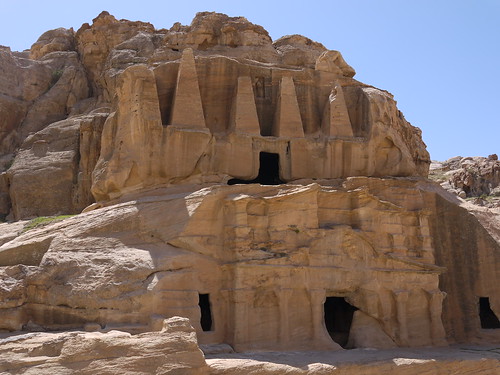
Is it just me or do those columns at the upper level of the picture above look a bit art deco-ish? Of course, there are many ancient Egyptian influences in art deco so maybe we owe something to the Nabateans too!
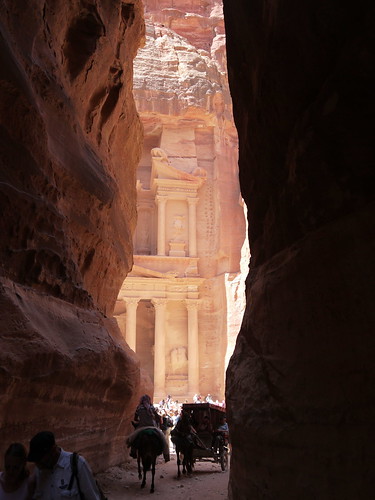
It takes about 40 minutes from the entering the site before you get a hint of the prize at the end of the Sik (pictured above) - the monumental Al-Khazneh, sometimes known as the treasury. The walk is cool in the shade from the rocks but visitors must be careful as donkeys, horses and carriages rush up and down carrying visitors to and from the Al Khazneh and beyond.
Emerging from the Sik is surely the highlight of the visit as the narrow, winding gorge suddenly widens into a large square in front of a pink building over 40 metres high that has been there since the first century BCE. Until fairly recently, some Bedouin families lived in the tombs and had a long established presence here until the Jordanian government persuaded them to move to a "new" Petra close by. Although the Bedouin knew about the site, it had been forgotten in the west until in 1812 a Swiss traveler called Johann Ludwig Burckhardt "rediscovered" it. A good idea of what Burckhardt would have seen can be gained from the pictures David Roberts produced in the 1830's and later.
As with almost all of the other structures on the site, the Al-Khazneh (pictured below) is a tomb, probably for an important Nabatean king, although there is some evidence that it was used as a temple in later times. The architectural style of the building shows Hellenistic (Greek) influences and it is thought that the Nabateans were good at absorbing styles from a variety of cultures.
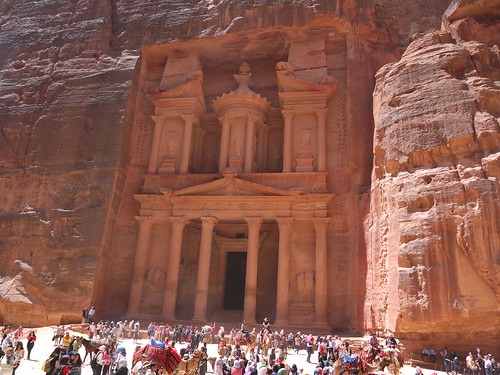
Petra's tombs show a clear class structure according to size and external grandeur with the largest most externally ornate tombs being for royalty, important people and the wealthy. Interestingly the interiors of the tombs are not decorated - unlike those of the ancient Egyptians. However, some of them have natural decoration with incredible patterned ceilings, with swirls, stripes and speckles in Petra's pinks, reds and oranges (pictured below).
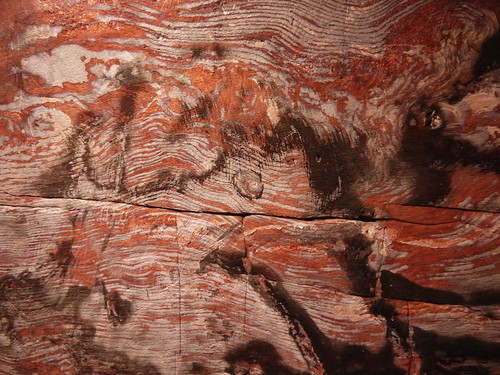
Interestingly, almost nothing is left from the living quarters of ancient Petra, which are thought to have been located away from the collection of tombs on the hillside. However, it is believed that only about 30% of Petra's remains have been excavated and uncovered and that more homes may yet be discovered. Although there are very few homes to see, there is a very impressive auditorium or theatre (pictured below) in the heart of he tomb area indicating that daily life also took part in this area. This is located in the Outer Siq or street of facades, which may have been the main thoroughfare of the city. It resembles a Roman theatre but was in fact built by the Nabateans in the first century albeit with clear Roman influences. With the exception of a free standing front on either wing (now gone), the theatre was carved out of the rock. At its peak it was able to hold as many as 7000 people.
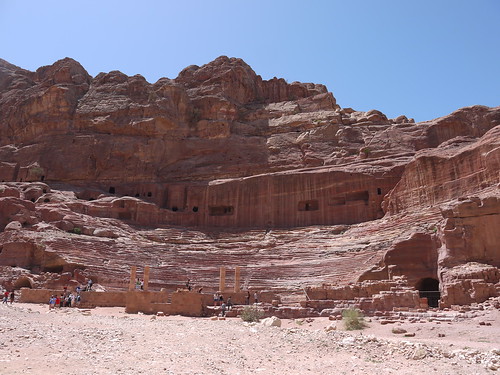
It is possible to see a fair amount of the site in a day trip like the one I took, but to see most of Petra and to have time to contemplate and view in depth, it is probably better to stay overnight and it is easy to find organised tours on the internet. My visit was slightly extended when our enterprising Jordanian guide suggested that the seven of us might like to add a 45 minute look at some additional parts of the site - on donkeys! I happily went along with my six new friends who came from the USA, Hungary, Colombia and Guatemala and climbed on to the donkey with the help of an elderly looking Bedouin.
I had never ridden a donkey before and was grateful for the help of a small boy who walked beside me, occasionally jumping on to the back and saying "taxi! taxi!". He told me he was 11, although he looked younger, and that he liked school. I asked him the donkey's name and he responded by asking me where I was from. When I told him London he said the donkey was called Susan and was going to "have a baby". As well as feeling bad about riding a poor pregnant donkey, albeit with a lovely English name, I was also worried in case she went into labour before we reached our destination. She didn't, but there was other entertainment.
Two young Japanese women were happily sharing a donkey ride and laughing and waving to their friends who were lagging behind. Laughing and waving until the donkey bolted and rushed off up the steep hillside to their screams and the laughter of the Bedouin onlookers who gave chase and rescued them. These two women had another very elegantly but somewhat inappropriately dressed friend - wearing silk shorts and blouse, a floppy hat and exquisite shoes. Unfortunately she was terrified of her donkey, jumped off and tried to climb up the hillside in a state of distress. I felt sorry for her, but more sorry for the small Bedouin boy who was probably more scared than she was and was visibly worried, although I saw them both later on and they seemed recovered.
The big finish to the entertainment was also unexpected. With no warning, a male donkey jumped onto the back of a female and you can imagine the rest. Mass hysteria followed with people laughing, screaming, covering the eyes of children and looking on in total surprise at the finale to the visit. I was surprised that they still had the energy after carrying tourists all day!
Petra was built in around 200 BCE by the ancient civilisation, the Nabateans. They are thought to have come from the Arabian peninsula, possibly Yemen and were accomplished people, open to external influences and with skills in trading. There are remains of other Nabatean cities in the region, including at Mamshit and Shivta in Israel.
The city is approached through a 1,200 metres deep and very narrow gorge known locally as the Sik. The Sik is a stunning natural feature with many unusual geological formations, water channels cut into the rocks during the Roman period and best of all, rocks of deep red, pink and every colour in between. As with architecture, many of Petra's best features are a long way above eye-level, so look to see the amazing natural patterns in the rock, perfect stripes, ficus and oleander growing high up as well occasional carvings. There are also some votive niches carved into the rock and these once held statues of the many Nabatean gods - a technique used in Catholic countries to display representations of the Madonna.
The highlights of Petra come after one has passed through and emerged from the Sik, but there are many interesting sites as one approaches the famous gorge. These include ornate tombs of middle class people, clearly visible textual carvings - some of which resembles Hebrew (the Nabateans' language may well have been related to Aramaic) and more interesting and unusual rock formations. One of the more interesting tombs on the way to the Sik is pictured below.

Is it just me or do those columns at the upper level of the picture above look a bit art deco-ish? Of course, there are many ancient Egyptian influences in art deco so maybe we owe something to the Nabateans too!

It takes about 40 minutes from the entering the site before you get a hint of the prize at the end of the Sik (pictured above) - the monumental Al-Khazneh, sometimes known as the treasury. The walk is cool in the shade from the rocks but visitors must be careful as donkeys, horses and carriages rush up and down carrying visitors to and from the Al Khazneh and beyond.
Emerging from the Sik is surely the highlight of the visit as the narrow, winding gorge suddenly widens into a large square in front of a pink building over 40 metres high that has been there since the first century BCE. Until fairly recently, some Bedouin families lived in the tombs and had a long established presence here until the Jordanian government persuaded them to move to a "new" Petra close by. Although the Bedouin knew about the site, it had been forgotten in the west until in 1812 a Swiss traveler called Johann Ludwig Burckhardt "rediscovered" it. A good idea of what Burckhardt would have seen can be gained from the pictures David Roberts produced in the 1830's and later.
As with almost all of the other structures on the site, the Al-Khazneh (pictured below) is a tomb, probably for an important Nabatean king, although there is some evidence that it was used as a temple in later times. The architectural style of the building shows Hellenistic (Greek) influences and it is thought that the Nabateans were good at absorbing styles from a variety of cultures.

Petra's tombs show a clear class structure according to size and external grandeur with the largest most externally ornate tombs being for royalty, important people and the wealthy. Interestingly the interiors of the tombs are not decorated - unlike those of the ancient Egyptians. However, some of them have natural decoration with incredible patterned ceilings, with swirls, stripes and speckles in Petra's pinks, reds and oranges (pictured below).

Interestingly, almost nothing is left from the living quarters of ancient Petra, which are thought to have been located away from the collection of tombs on the hillside. However, it is believed that only about 30% of Petra's remains have been excavated and uncovered and that more homes may yet be discovered. Although there are very few homes to see, there is a very impressive auditorium or theatre (pictured below) in the heart of he tomb area indicating that daily life also took part in this area. This is located in the Outer Siq or street of facades, which may have been the main thoroughfare of the city. It resembles a Roman theatre but was in fact built by the Nabateans in the first century albeit with clear Roman influences. With the exception of a free standing front on either wing (now gone), the theatre was carved out of the rock. At its peak it was able to hold as many as 7000 people.

It is possible to see a fair amount of the site in a day trip like the one I took, but to see most of Petra and to have time to contemplate and view in depth, it is probably better to stay overnight and it is easy to find organised tours on the internet. My visit was slightly extended when our enterprising Jordanian guide suggested that the seven of us might like to add a 45 minute look at some additional parts of the site - on donkeys! I happily went along with my six new friends who came from the USA, Hungary, Colombia and Guatemala and climbed on to the donkey with the help of an elderly looking Bedouin.
I had never ridden a donkey before and was grateful for the help of a small boy who walked beside me, occasionally jumping on to the back and saying "taxi! taxi!". He told me he was 11, although he looked younger, and that he liked school. I asked him the donkey's name and he responded by asking me where I was from. When I told him London he said the donkey was called Susan and was going to "have a baby". As well as feeling bad about riding a poor pregnant donkey, albeit with a lovely English name, I was also worried in case she went into labour before we reached our destination. She didn't, but there was other entertainment.
Two young Japanese women were happily sharing a donkey ride and laughing and waving to their friends who were lagging behind. Laughing and waving until the donkey bolted and rushed off up the steep hillside to their screams and the laughter of the Bedouin onlookers who gave chase and rescued them. These two women had another very elegantly but somewhat inappropriately dressed friend - wearing silk shorts and blouse, a floppy hat and exquisite shoes. Unfortunately she was terrified of her donkey, jumped off and tried to climb up the hillside in a state of distress. I felt sorry for her, but more sorry for the small Bedouin boy who was probably more scared than she was and was visibly worried, although I saw them both later on and they seemed recovered.
The big finish to the entertainment was also unexpected. With no warning, a male donkey jumped onto the back of a female and you can imagine the rest. Mass hysteria followed with people laughing, screaming, covering the eyes of children and looking on in total surprise at the finale to the visit. I was surprised that they still had the energy after carrying tourists all day!
No comments:
Post a Comment